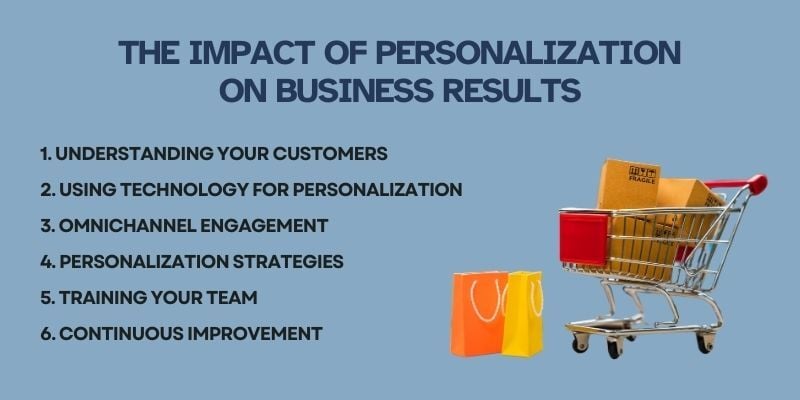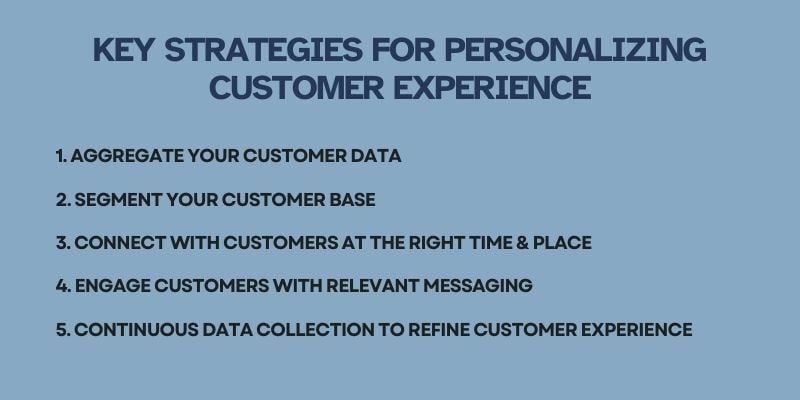Today, customers expect brands to know what they want and deliver customized experiences. A personalized customer experience helps businesses meet these expectations by offering relevant recommendations, customized communication, and seamless interactions.
When done right, personalization makes customers feel valued, increasing satisfaction and long-term loyalty.
With so many choices available, brands that personalize stand out from the competition. Whether they use past purchases to suggest new products or provide support based on customer preferences, personalization strengthens relationships and builds trust.
This is no longer a nice-to-have but a must for businesses looking to grow and keep customers engaged.
What is a Personalized Customer Experience?

A personalized customer experience is when businesses interact with customers in a way that feels relevant to them. Instead of offering everyone the same products, services, or messages, companies use customer data such as past purchases, browsing history, and preferences to provide experiences that match individual needs.
This can include product recommendations, customized emails, or customer support that understands their concerns without them having to repeat information. A tailored customer experience makes customers feel recognized and valued rather than just another transaction.
Personalization is more than just making things easier. It strengthens relationships between businesses and customers by making interactions smoother and more meaningful. When people feel that a brand understands them, they are likelier to return, recommend it to others, and remain loyal.
In short, customers engage more with businesses that personalize their experience, leading to higher satisfaction, trust, and long-term success for the company.
The Impact of Personalization on Business Results

Personalization significantly impacts business performance by increasing revenue and strengthening customer loyalty. A McKinsey report shows that companies focusing on personalized marketing can boost revenue by 5–15% and improve marketing return on investment (ROI) by 10–30%.
Customers now expect businesses to offer personalized experiences. 71% want customized interactions, and 76% feel frustrated when they do not receive them. Businesses that focus on personalization generate 40% more revenue than those that don’t.
Apart from increasing revenue, personalization helps businesses retain customers. Businesses can offer relevant recommendations and support by analyzing customer preferences and behaviors, building trust and engagement.
Leading retailers use digital tools to enhance personalized online and in-store shopping experiences. For example, IKEA Dubai implemented Wavetec’s UNO-Q Queue Management System to streamline its in-store service.
The system, featuring Donatello digital signage, visually guided customers to the correct queue and available counters, eliminating guesswork and confusion during peak hours.
This personalized strategy created a smoother and more intuitive checkout process, significantly reducing wait times and enhancing customer satisfaction.
1. Understanding Your Customers
Businesses need to understand their audience to create a personalized client experience. This means gathering data, studying behaviors, and recognizing customers’ wants at different journey stages.
Businesses focusing on deeper insights, such as customer motivations and expectations, can create stronger, more meaningful connections. The more accurate the understanding, the better businesses can engage customers, improve satisfaction, and build long-term loyalty.
Develop Customer Profiles
Creating detailed customer profiles helps businesses provide the right products, services, and support. These profiles should include age, location, purchase history, browsing habits, and personal preferences.
Some companies also track psychological factors like values and interests to refine their approach further. Businesses using these insights effectively can predict customer needs, offer timely recommendations, and ensure a smooth experience across digital and physical interactions.
Another effective method is developing customer personas to improve customer experience by segmenting audiences based on common traits, behaviors, and motivations. By understanding these personas, businesses can refine their marketing efforts, anticipate customer needs, and customize interactions more effectively.
Gathering Feedback
Customer feedback solutions are important for improving personalization. Businesses can collect insights through surveys, Net Promoter Score (NPS) ratings, and direct interactions like chatbots, social media, or customer service conversations.
Analyzing customer sentiment and behavior in real-time helps companies identify patterns, address concerns quickly, and continuously improve their personalized experiences.
Encouraging open communication and acting on feedback builds trust, making customers feel valued and understood.
2. Leveraging Technology for Personalization
Technology is changing how businesses connect with customers, making interactions more relevant and engaging. AI, data analytics, and CRM systems help companies understand customer behavior, predict needs, and deliver personalized solutions instantly.
For example, Samsung Spain implemented Wavetec’s Digital Queue System at their service centers to improve the customer experience. The system allowed customers to book appointments and receive digital queue tickets via WhatsApp, making managing their time and avoiding long waits easier. Additionally, premium customers with high-end devices received prioritized service, further improving the experience.
In short, using the right tools can improve satisfaction, increase customer retention, and gain a competitive advantage. Investing in customer personalization strategies strengthens relationships and boosts business growth by refining marketing efforts and streamlining customer service.
Using AI and Data Analytics
AI allows businesses to analyze large amounts of customer data to uncover valuable insights. Machine learning tracks past interactions to predict future preferences, helping companies offer personalized product recommendations, exclusive promotions, and proactive support.
AI-driven chatbots and virtual assistants enhance personalized customer interactions by providing instant, relevant responses based on customer history. Over 92% of businesses use AI-driven personalization to drive growth, demonstrating its crucial role in improving customer engagement and retention.
By using AI in their strategies, businesses can automate processes, boost efficiency, and build meaningful connections with their audience.
Customer Relationship Management (CRM) Systems
CRM systems are essential for managing personalized customer experiences by storing and organizing data from multiple channels. They give businesses a complete view of customer preferences, purchase history, and engagement patterns, helping teams offer customized marketing, anticipate needs, and provide proactive support.
Advanced CRM platforms use AI and automation to streamline communication, ensuring customers receive timely responses and relevant offers. By using CRM insights, businesses can create smooth, omnichannel experiences that develop long-term loyalty.
3. Omnichannel Engagement
In today’s digital world, customers want to connect with brands across multiple platforms, like social media, email, or phone, without disruptions. Omnichannel engagement helps businesses meet these expectations by ensuring their messaging is consistent and the experience is smooth, no matter which platform the customer uses.
When businesses adopt omnichannel strategies, they can reach customers wherever they are, providing a more personalized and convenient experience.
Creating a Seamless Experience Across Channels
Various communication channels, such as social media, email, and phone, are important for delivering consistent and uninterrupted messaging. Customers should be able to switch from one platform to another, whether chatting on social media or continuing a conversation over email, without losing continuity in their experience.
This creates a seamless flow that ensures customers receive the support and information they need at every step. By offering individualized customer service and maintaining consistent communication, businesses can build trust and ensure customers feel supported at every touchpoint.
Empowering Customers with Choices
Allowing customers to choose their preferred communication channels significantly enhances their experience and satisfaction. Whether they want a quick chat via a chatbot, a more detailed discussion through email, or a phone call with a customer service agent, the freedom to decide how to interact makes them feel in control and valued.
An effective omnichannel customer experience ensures that no matter which platform they use, the service remains seamless and personalized.
Offering individualized customer service on the channels customers prefer helps businesses cater to different needs and preferences, ensuring better overall satisfaction and encouraging long-term relationships.
4. Personalization Strategies
Personalization is vital for improving businesses’ interactions with customers. By adjusting their services and messages to meet the specific needs of individual customers, businesses can strengthen relationships, increase satisfaction, and ultimately drive success.
When companies personalize their strategies, they engage customers more meaningfully, building loyalty and ensuring long-term growth. Personalized marketing for customers boosts engagement and enhances the overall experience by delivering content and offers that speak directly to their interests and needs.
Tailored Messaging and Offers
Personalized content and promotions based on customer behavior are important for boosting engagement and conversions. By analyzing customer data, such as past purchases, browsing habits, and preferences, businesses can create targeted messages that are more likely to capture attention.
This lets them offer relevant products, services, or discounts at the right time, ultimately enhancing personalized customer interactions. By delivering customized messaging, businesses increase the likelihood of meeting customers’ specific needs, improving their overall experience.
Self-Service Options
Offering self-service resources like FAQs and instructional videos helps customers find solutions independently, giving them greater control and improving their overall experience. These resources also make it easier for customers to resolve issues quickly, enhancing their satisfaction and reducing the need for support.
By providing easy access to this information, businesses can reduce wait times, build trust, and ensure customers feel empowered. Self-service options are essential to a personalized strategy focusing on customer independence and help businesses offer smoother, more efficient service.
5. Training Your Team
Training your team to interact effectively with customers is crucial for outstanding service. A well-trained team solves problems quickly and improves the overall experience by offering personalized, understanding interactions.
Investing in training prepares your staff to meet various customer needs, ensuring consistent customer service that develops long-term customer loyalty.
Customer-Facing Employee Training
Training employees to handle emotional interactions with care and professionalism is essential for offering personalized support. Since customer-facing staff are the first people customers interact with, their ability to manage simple and emotional situations significantly impacts customer satisfaction.
Equipping your team with skills to navigate difficult conversations and offer custom solutions helps customers feel valued. Additionally, focusing on proactive customer service, like anticipating customer needs before issues arise, can significantly enhance the overall experience.
Ongoing emotional intelligence and communication training are also important for building positive customer relationships and enhancing personalized interactions.
Creating a Customer-Focused Vision Statement
A clear, customer-focused vision statement sets the direction for your entire company. It provides guiding principles that help all employees understand the importance of customer experience and how they can contribute to it.
By aligning their team with this shared vision, businesses ensure that every employee, whether in sales, support, or behind the scenes, works towards improving the customer experience.
This approach helps create a culture where customer satisfaction is always prioritized, leading to more consistent and meaningful interactions.
6. Continuous Improvement
Today, businesses must regularly adjust their strategies to stay competitive. Continuous improvement helps personalization efforts keep up with changing customer needs, trends, and new technologies.
By consistently reviewing and refining customer engagement strategies, businesses can stay relevant and provide exceptional experiences, creating a customized customer journey. Adapting your business to evolving customer expectations is important for staying ahead of the competition.
Performance Tracking and Analysis
Using analytics tools to track the effectiveness of personalization efforts is essential for understanding what is effective and what needs improvement.
By examining customer data and engagement patterns, businesses can spot trends, measure the success of their strategies, and make informed decisions. This ongoing assessment ensures that personalization remains meaningful and continues to improve customer satisfaction and loyalty.
In fact, McKinsey suggests that US companies alone could add $1 trillion in revenue by further embracing personalization, showcasing the critical role of personalization strategies in driving growth.
By continuously evaluating and refining these strategies, businesses can keep their offerings relevant and continue to meet customer expectations, leading to increased engagement and revenue.
Adapting Based on Customer Insights
Customer preferences change constantly, so businesses must adjust their strategies based on feedback and data. Regularly updating personalization efforts lets companies stay in tune with customers’ expectations.
Businesses can use these insights to modify their marketing, products, and services to meet individual needs better, strengthening customer relationships and improving the overall experience.
This adaptability helps businesses continue creating a customized customer journey that resonates with their audience.
Key Strategies for Personalizing Customer Experience

Personalization helps businesses stay competitive by making customer interactions feel more relevant. It boosts satisfaction, builds customer loyalty, and drives long-term growth. Here are some key strategies to create personalized experiences that connect with customers:
1. Aggregate Your Customer Data
Personalization starts with understanding your customers, which means collecting data from various sources. Businesses can create complete customer profiles by gathering data from website visits, social media, purchase history, and customer service interactions.
Using Integrated Data
CRM systems and analytics platforms help businesses consolidate and analyze this data. These tools let companies group customers based on shared traits, behaviors, and preferences, helping them create more personalized marketing campaigns.
With this data, businesses can target customers with content that fits their unique needs through email, mobile, or social media.
2. Segment Your Customer Base
Customer segmentation allows businesses to group individuals by shared characteristics, such as behavior, needs, or demographics. This approach helps businesses offer more relevant content and personalized promotions.
For example, an online store might target customers based on what they’ve bought before, sending tailored product recommendations more likely to result in a sale.
Precise Targeting
Segmenting customers lets businesses create more specific marketing strategies. For example, companies can identify high-value customers or those who need extra attention to purchase.
Psychographic segmentation takes this further by grouping people based on their interests or lifestyles. This allows businesses to create messages that resonate with their core beliefs.
3. Connect with Customers at the Right Time and Place
Customer touchpoints are the points where customers interact with a brand, such as website visits or social media engagement. By identifying these moments, businesses can communicate with customers when they are most likely to respond.
The Importance of Timing
Personalization works best when it’s timely. By tracking customer behavior, businesses can send messages at the right moment. For example, sending an email after someone abandons their shopping cart or offering a discount on a customer’s birthday can increase engagement.
Brands that understand their customers’ needs and respond quickly build stronger, more meaningful relationships.
4. Engage Customers with Relevant Messaging
Personalized messaging is one of the most powerful ways to engage customers. By customizing content to fit a customer’s preferences, businesses are more likely to spark meaningful interactions.
Businesses can use data from past purchases, browsing habits, and demographics to create targeted messaging for each customer.
Product Recommendations
AI-powered recommendation systems are a great way to personalize content. For example, Amazon suggests products based on what others have bought, and Netflix recommends shows based on viewing history.
Businesses can make customers feel valued and understood by offering relevant suggestions and encouraging loyalty.
5. Continuous Data Collection to Refine Customer Experience
Customer preferences and behaviors change over time, so it’s important to keep collecting and analyzing data. This ensures that personalization efforts stay effective and up to date.
Feedback and Metrics
Businesses should collect customer feedback through surveys, reviews, and social media to better understand their needs. Analyzing engagement metrics like email open rates and conversion rates can help measure the success of personalized campaigns.
This ongoing analysis allows businesses to adjust and deliver personalized experiences that improve customer satisfaction and loyalty.
Examples of Successful Personalization
Here are examples of companies using personalization to improve customer loyalty and engagement:
1. Spotify:
Spotify uses AI to create personalized playlists, such as “Discover Weekly” and “Release Radar,” which enhance the listening experience. The company also runs Spotify Wrapped, a campaign where users receive a personalized summary of their listening habits.
Personalization increases engagement and strengthens customer loyalty. It has been crucial to Spotify’s success, helping it grow its dedicated user base.
2. Rappi:
Rappi, a Latin American delivery service, personalizes its offerings through customer data, tailoring recommendations and promotions to meet users’ unique needs. This personalization helps the company drive customer engagement and increase sales, such as through campaigns sent via WhatsApp.
By segmenting users into groups like “active” and “lapsed” customers, Rappi can target personalized content to the right audience, improving both retention and conversion rates.
3. Takealot:
Takealot, South Africa’s top e-commerce platform, uses advanced customer data analysis to personalize the shopping experience. By tracking user browsing and purchase history, Takealot recommends products customized to individual preferences, significantly increasing conversion rates and customer satisfaction.
The platform also uses segmentation strategies, ensuring that different customer groups receive the most relevant content and offers.
How Wavetec Helped Brands Achieve Personalization CX
Here are enhanced examples of how Wavetec helped various brands achieve personalized customer experiences through innovative strategies:
1. AzerConnect:
AzerConnect, a major telecom provider in Azerbaijan, faced the challenge of improving customer experience and engagement across their services. By adopting Wavetec’s advanced customer experience management solutions, AzerConnect implemented personalized digital touchpoints and real-time customer data analytics.
This allowed them to tailor interactions and provide customized offers, improving customer satisfaction and loyalty. Using these tools helped streamline operations and enabled a more responsive service model.
2. HSBC Mexico:
HSBC Mexico aimed to enhance its customer service experience by integrating Wavetec’s personalized digital and in-branch solutions. With Wavetec’s support, HSBC Mexico was able to streamline the banking experience, making it more convenient for customers through personalized communication and offers based on their financial behaviors.
This led to greater customer satisfaction, increased engagement, and long-term loyalty. Wavetec’s technology provided HSBC with the tools to continuously refine and optimize their customer experiences, ensuring they met evolving needs.
3. Adamjee Insurance:
Adamjee Insurance, one of the leading insurance providers in Pakistan, wanted to enhance its customer relationships and increase retention. By partnering with Wavetec, Adamjee used personalized communication strategies and real-time customer feedback loops to understand policyholders’ preferences better.
This allowed them to offer customized products, improve service delivery, and develop stronger customer relationships. The personalized touch helped them stand out in a competitive market, ultimately driving customer satisfaction and increasing their retention rate.
Conclusion
Personalized customer experiences are crucial for standing out in today’s market. Businesses can implement a customer-centric strategy to boost engagement, satisfaction, and loyalty by customizing interactions to meet their needs.
Personalized marketing generates quick sales and builds strong, long-lasting relationships. Companies like Spotify, Rappi, and Takealot demonstrate how personalization helps create deeper, more meaningful customer connections.
To achieve this, businesses must consistently collect data, segment their audience, and deliver timely, relevant messages. These efforts help companies create lasting customer relationships, which are essential for sustained growth and long-term success.
BOOK A FREE DEMO





